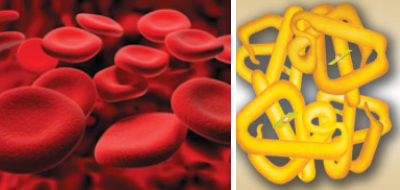 |
Hemoglobin, which gives blood its color, serves a vital purpose in loosely bonding with oxygen, which enables the cells to live, and distributing it throughout the body, and removing the carbon dioxide that those same cells give off. |
You are probably unaware of the great efforts being made in your body to keep you alive. While you work, grow tired, sleep, eat or play sports, this feverish activity in your body keeps going non-stop. Molecules programmed to keep you healthy perform their duties without your being aware of them, never making a mistake, never growing bored, and never resting.
Hemoglobin, which gives your blood its red color, is just one of the countless molecules comprising the human body. Its vital function is to keep every cell in the body alive. Oxygen, which every cell needs is distributed, and the carbon dioxide that cells need to discard is picked up by hemoglobin.
On its own, just breathing is not enough to keep a body alive. It must somehow distribute the oxygen to 100 trillion cells, and pick up the carbon dioxide produced by metabolism. Our lives depend on the activity of this very complex micro-system. No scientific studies have been able to develop any mechanism that's able to transport oxygen in the way that hemoglobin does.
It is an extraordinarily complex molecule with its own unique structure. With all its properties, this complex molecule is a miracle of Omniscient and Almighty God. In examining the features of this great miracle, we must always recall that God has the power to create splendid works, and that He has brought these structures and systems into existence in the bodies of all human beings.
Grasping this truth is one of the most important means of giving thanks to and praising Him. In one verse of the Qur'an God has revealed:
He is the Living—there is no god but Him—so call on Him, making your religion sincerely His. Praise be to God, the Lord of all the worlds. (Surah Ghafir: 65)
 |
He brings forth the living from the dead and brings forth the dead from the living and brings the Earth to life after it was dead.In the same way you too will be brought forth.(Surat ar-Rum:19) |
Scientists' description of hemoglobin as an "extraordinary molecule" is based on the fact that it's able to perform different jobs at the same time. Hemoglobin selects oxygen from the millions of molecules passing through the capillary vessels in the lungs. This procedure is as stunning as it is intelligent. Hemoglobin literally catches oxygen atoms with its own unique process—which, however, must be carried out in a very sensitive manner, because the oxygen to which it binds possesses the property of oxidation, a destructive and toxic process that causes the molecule to lose its functions.
To protect against that danger, God has created hemoglobin with a magnificent property: As it transports oxygen, hemoglobin does not fully bind to it, but grabs the molecule from one end, just as if it were using a pair of tongs, and carries it to its destination in that manner. This method, doubtless, is very well-advised. Almighty God has created it together with this important precaution against the threat of oxidation.
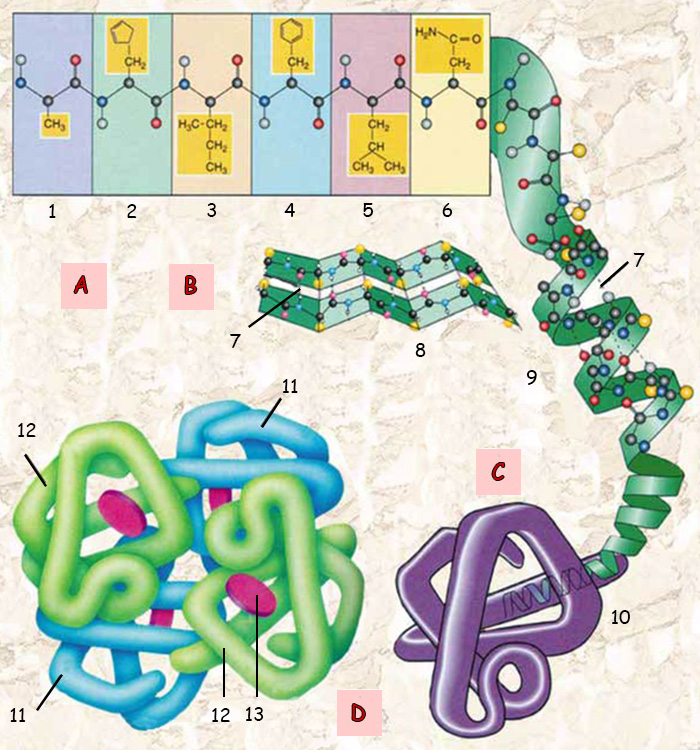 | |
1. Amino Acid 1 | 7. Hydrogen Bond |
A. PRIMARY STRUCTUREDetermined by the number, type and order of amino acids, and forms a polypeptide. B. SECONDARY STRUCTUREPolypeptide can form a beta-pleated sheet or an alpha helix. Hydrogen bonds form between carboxyl and amino acids. | C. TERTIARY STRUCTUREOccurs when the helix (or sheet) is folded in specific ways, and is characteristic of globular proteins. D. QUATERNARY STRUCTUREThe folded protein chains may join to form a single protein consisting of several subunits. For example, the oxygen-carrying protein hemoglobin possesses two alpha chains and two beta chains. |
The above diagram shows the phases through which hemoglobin forms. Hemoglobin has a very complex and perfect structure in order to be able to transport oxygen. Therefore, any change in its amino-acid configuration will make it lose its ability to transport oxygen. | |
Anyone who considers this with an open mind will clearly perceive the signs of creation here. There is no possibility that hemoglobin itself could have discovered the threat posed by oxygen and developed a countermeasure, all by using trial and error. Above all, we are talking about a mere molecule. This important security precaution, with all its complexity, was created at exactly the same time when hemoglobin first came into being. The biological details that permit hemoglobin to trap oxygen clearly reveal that no such mechanism could ever have come into being by chance.
The hemoglobin molecule contains a protein consisting of four chains known as globins. Each globin is bound to another molecule known as a heme group, which is exceedingly important in binding the oxygen to hemoglobin. Each heme group carries one ion of iron. This means that the four heme groups carry four iron ions. The iron ions bind to the oxygen in the lungs and then release it in the tissues.
Necessary Precautionary Measures for Transporting Oxygen | |
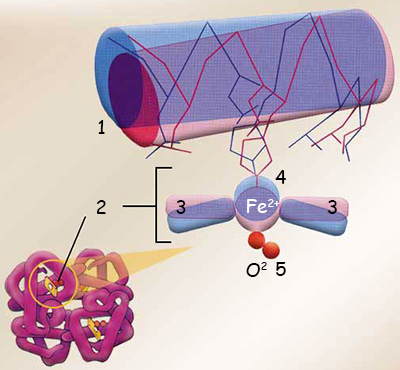 | 1. F helix 3. Porphyrin |
The four heme groups in the hemoglobin molecule are involved with binding and carrying oxygen. These heme groups are initially parallel to one another, but when they bind an oxygen molecule they lose their parallel alignment and each causes changes in the structure of the globin surrounding it. Globin prevents oxygen links from forming among the iron ions by the oxygen molecules' approaching one another. Thanks to this extremely important precaution, the two hemoglobin iron atoms are prevented from being oxidized. The approximately 270 hemoglobin molecules in every red blood cell take this important precaution constantly. | |
Globin, however, also plays an important role in this process. As you shall soon see, globin's shape is an important control mechanism—and another matchless marvel of creation. In addition, the smallest change in this molecule's amino acid sequence entirely alters hemoglobin's ability to transport oxygen.
At the outset, while describing the features of the blood, you were reminded that every detail contains many other very different and complex sub-details. And the more one delves into the small components of the system, the more this complexity and variety increase. The way that God has created such details and complexity, while making all their existence essential to the functioning of the system, has left those unwilling to admit to the truth of creation with no alternative explanations to offer. Examples like this strengthen believers' faith in God. Since all these technical details reveal this complexity in great detail, they leave deniers in a state of doubt, whereas believers can rejoice in their trust and determination.
As we continue to examine the details of the system, you shall see that globin's very special shape controls the way iron binds to oxygen. The four hemes in the hemoglobin molecule are parallel to one another and vertical to the globin polypeptide chains. However, when the heme groups bind oxygen, this parallel alignment is lost. Even though the hemes are too far apart to interact direcly, changes that occur in the globin's structure that surrounds the heme when it picks up an oxygen molecule are transmitted to the other globins in this protein. Thus, the act of binding an oxygen molecule at one heme leads to an increase in the affinity for oxygen binding at the adjacent hemes.
It should also be noted that the globin keeps pairs of heme groups from coming too close together, thanks to which, an oxygen link that might otherwise form among the irons is prevented from doing so. If an oxygen link or "bridge" did form, then two valuable hemoglobin iron atoms would be oxidized.24
We may compare this to four separate magnets left hanging from a rod. Since the magnets' north poles are all adjacent, they will repel one another. If every magnet repels another one of the same polarity that approaches it, then we encounter a situation in which all these magnets seek to move away from one another and thus change their alignment.
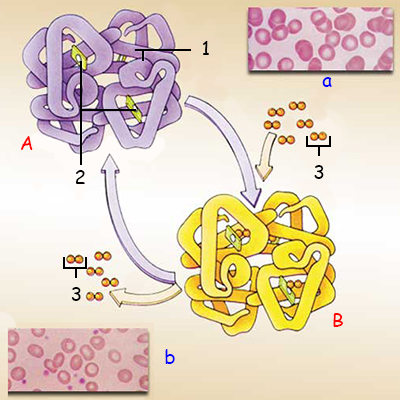 | A. HEMOGLOBIN 1. Globin chains b. In iron-deficiency anemia, the number of red blood cells is low. Their color is pale due to the lack of hemoglobin, and they carry less oxygen than normal red blood cells. a. Normal blood: The oxygen-receptive hemoglobin molecules give blood its red color. |
Hemoglobin has a miraculous oxygen-carrying ability, that permits it to bind four separate oxygen molecules. It carries these molecules with great care throughout the circulatory system and deposits them in tissues that need oxygen. |
When iron ions bind oxygen, they act just like magnets with the same polarity and try to distance themselves from each other as far as possible. In our analogy, the "rod" on which the magnets are suspended is the globin. The threads by which the magnets hang are the heme groups, and the magnets themselves are oxygen. The way hemoglobin binds four separate oxygen molecules is clearly the creation of God to meet the body's oxygen requirements.
If you keep in mind that each red blood cell carries up to 270 hemoglobin molecules, the scale how each cell distributes oxygen in the body can be better understood. It is essential that this distribution system should have the perfect, special organization just described. It is as if the molecules in question were able to calculate the potential oxidation danger that oxygen molecules bring with them and behave in the awareness that therefore, they must move as far away from one another as they can.
More importantly, the same precaution has been taken in the trillions of molecules in every human body. That is because these are examples of God's creation, and are kept under His control at every moment. Each one is a manifestation of God's name of Al-Qadee (the Ruler; He Who completes His task). Like every other example of creation on Earth, they introduce us to the existence, infinite might and omniscience of God. Our Lord's superior knowledge is revealed in these terms in the Qur'an:
That is the Knower of the Unseen and the Visible, the Almighty, the Most Merciful. He Who has created all things in the best possible way. He commenced the creation of man from clay. (Surat as-Sajda: 6-7)
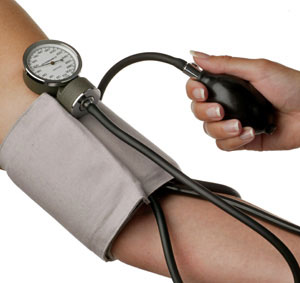 |
Thanks to the nitrogen monoxide it carries, hemoglobin "knows" how much oxygen to release in which tissue. The nitrogen monoxide transported by hemoglobin ensures that blood pressure remains stable throughout the body. The amount of oxygen that needs to be released in the tissues is determined by the blood pressure. |
Throughout this transportation, an exceedingly loose bond is developed between the hemoglobin and oxygen molecules, which bond is easily reversible at any time. That this loose bond is another marvel of creation becomes clear at the next stage, because in order for oxygen to be able to be deposited at the requisite tissues, it needs to be able to separate easily from the hemoglobin. The loose bond between them facilitates this. If a stronger bond were to develop, then despite being transported throughout the body, the oxygen molecules could not be deposited in the tissues as the red blood cells carrying the oxygen passed by. That, in turn, would spell certain death for us.
The existence and breaking point of this loose bond has been determined sensitively. The environment that allows the oxygen molecule to attach to the hemoglobin is high partial pressure of oxygen in the lung tissue. As the partial pressure of oxygen falls in other body tissues, the loose bond between the oxygen and hemoglobin breaks, separating the oxygen from the hemoglobin.
This mechanism forms the basis of the transportation of oxygen from the lungs to the tissues.25 Such a mechanism has to operate constantly in the body. If the partial pressure of oxygen does not fall at the requisite time and place, then the tissues will be unable to take oxygen in, and a tissue deprived of oxygen will shortly die.
The same thing applies to blood pressure. A hemoglobin molecule can determine how much oxygen it will release to a tissue only when blood pressure is stable. This pressure in the blood can remain stable thanks to nitrogen monoxide, another molecule carried by the hemoglobin molecule in addition to oxygen and carbon dioxide. If hemoglobin did not also carry nitrogen monoxide, then the blood pressure would constantly vary. Either insufficient oxygen would be provided to the requisite tissues, or else too much.26 This would mean that the tissues would either burn out from too much oxygen or die from too little.
All this information about the hemoglobin molecule confirms that its structure was especially created for life. Thus, this molecule represents a major dilemma for Darwinists, who ascribe the development of life on Earth entirely to coincidences. If Darwinists are to insist that hemoglobin is the product of chance-based mutations, then they must explain how the genetic information of the hemoglobin molecule, which enjoys such a sensitive chemical harmony with oxygen in the body, came into existence—and also how living things with circulatory systems managed to breathe before that genetic information enabled oxygen to be carried to their tissues.
Above all, the presence of hemoglobin is essential to the proper function of blood, and it cannot be expected to form and reach perfection gradually in any oxygen-breathing organism by means of random mutations. If hemoglobin had not possessed a very special structure with which to combine loosely with oxygen and thus transport it to the tissues, then to collect waste products in the tissues and deposit them back in the lungs, then blood circulation would have been useless. This shows us that in addition to such exceedingly complex tissues as the heart, venous network and blood, the circulation of the blood must have emerged together with special molecules such as hemoglobin right from the outset. To state that another way, the origin of the circulation of the blood obviously is not the end result of evolution, but of creation.
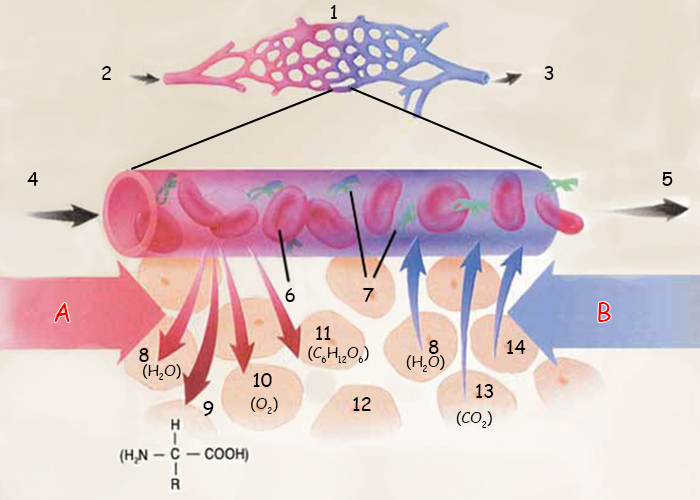 | |||
A. (Blood pressure = 40 mm Hg) - (Osmotic pressure = 25 mm) = (Net blood pressure = 15 mm) | |||
1. Capillary bed | 5. to venule | 9. Amino acids | 13. Carbon dioxide (CO2) |
The above diagram shows the exchanges that take place between the capillaries and tissues. At the arterial end of the capillary, blood pressure is higher than osmotic pressure—thus water, oxygen, amino acids and glucose tend to leave the bloodstream. At the venous end of the capillary, however, the situation is exactly reversed: Osmotic pressure is higher than blood pressure. Therefore, water, carbon dioxide and other waste molecules tend to enter the bloodstream. This perfect process, arising from pressure differences, enable oxygen and nutrients to be distributed throughout the body and waste products to be removed. | |||
To every question of how and why in the living world, the answer will be a clear exposition of the fact of creation. Therefore, Darwinists can never explain how the complex structure of life emerged. Every work that appears before them is a creation of God, Who has the power to do whatever He wishes. This fact is revealed in the Qur'an:
... I swear by the Lord of the Easts and Wests that We have the power. (Surat al-Ma'arij: 40)
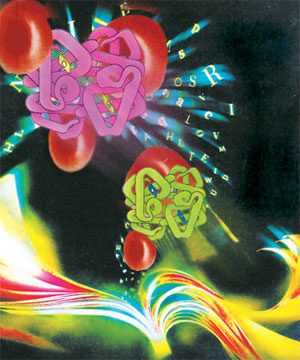 | |
In terms of both its structure and its functions, hemoglobin is a very special molecule. If hemoglobin were not so weakly bound to oxygen, and had not possessed, right from the beginning, the special structure that lets it transport that oxygen to the tissues, collect waste products from the tissues and deposit carbon dioxide in the lungs, then blood circulation would be useless. Hemoglobin was no doubt created at the same moment with the other elements of the circulatory system. To put it another way, the origin of the blood's circulation lies not in evolution— this system is just another proof of our Lord's superior creation. |
It's not only hemoglobin's oxygen-carrying ability that represents an insoluble dilemma for Darwinists. Hemoglobin also possesses the ability to collect the carbon dioxide molecules from the cells.
The transport of carbon dioxide in the blood is not as risky as carrying oxygen. For that reason, red blood cells can carry much larger quantities of carbon dioxide than they can of oxygen. During rest, 100 milliliters of blood carries an average of 4 milliliters of carbon dioxide from the tissues to the lungs. While the oxygen-carrying hemoglobin imparts a red color to the blood, on its return to the lungs hemoglobin loaded with carbon dioxide loses its bright color and assumes a dark reddish shade, akin to purple. That is why the veins close to the skin surface appear dark red or even blue.
The blood generally carries carbon dioxide in the form of carbonic acid. An average of only 5% is forwarded to the lungs by binding itself to hemoglobin. Another 10% of carbon dioxide is in a dissolved gaseous state.
Carbon dioxide attaches to hemoglobin with a rather weak bond. Once again, oxygen is the main factor at the stage of its being released from hemoglobin. In this chemical phenomenon, due to the hemoglobin's one particular property known as the Haldane effect, when oxygen binds with hemoglobin, carbon dioxide is released. When the tissues need oxygen, the Haldane effect separates hemoglobin from oxygen and causes it to bind more carbon dioxide. In the lungs, the same property has an opposite effect. There, where the level of oxygen is higher, oxygen behaves most expertly in binding with hemoglobin, and the higher acidity of the oxygenated hemoglobin promotes dissociation of carbon dioxide from the hemoglobin to which it is attached.27
The Haldane Effect: One of the Perfect Mechanisms of the Red Blood Cells | |
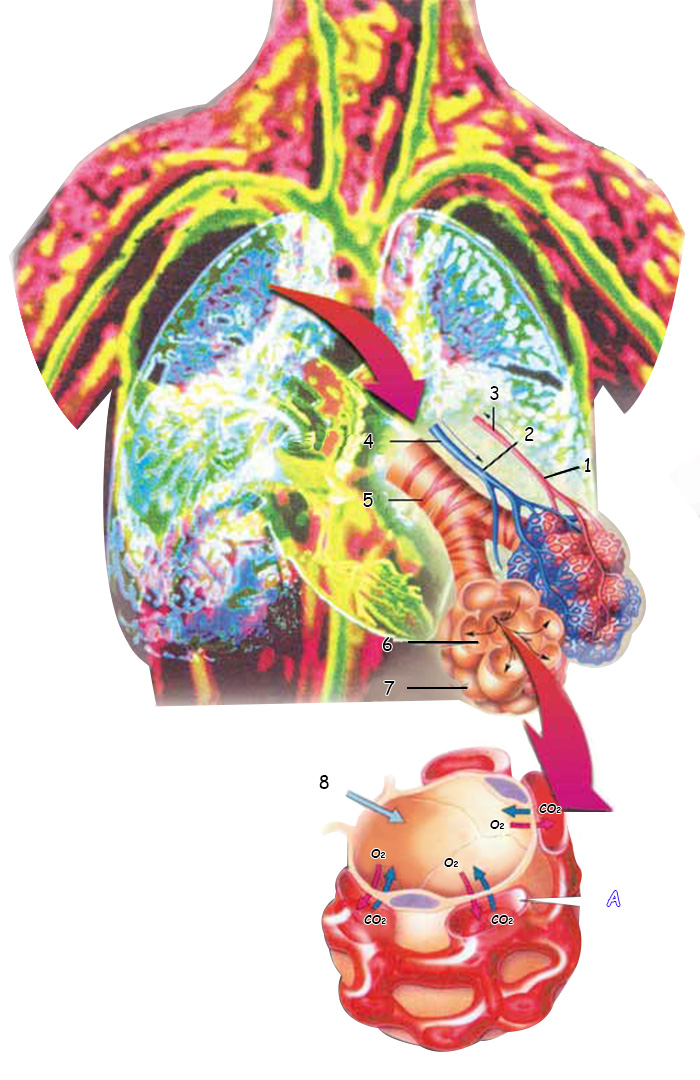 | |
1. Pulmonary venule (carrying a large quantity of O2) | 5. Bronchiole |
A. Oxygen transported by the red blood cells' hemoglobin passes from the alveolus to the capillary. Carbon dioxide passes from the capillary to the alveolus. | |
When the tissues need oxygen, the Haldane effect allows hemoglobin to release oxygen and bind with carbon dioxide molecules. In the lungs, the Haldane effect exhibits the exact opposite transfer, and the sites where hemoglobin exchanges oxygen and carbon dioxide are determined with perfect sensitivity. | |
This chemical process is exceedingly complex. The point that needs emphasis is that the sites where hemoglobin exchanges oxygen and carbon dioxide have been determined with the greatest sensitivity. Hemoglobin must release oxygen in the tissues and load up with carbon dioxide, and in the lungs—the exit point for carbon dioxide—the reverse of this exchange takes place. This exchange takes place nowhere else in the body. The chemical balance that maintains this cycle has to be fully functional at the same time as the circulation of the blood, and cannot possibly have evolved gradually, over the course of time, through random mutations.
Sometimes hemoglobin in the blood binds with carbon monoxide instead, generally through external influences, in a phenomenon known as carbon monoxide poisoning. If carbon monoxide (CO) gas from the incomplete combustion of coal or car exhausts is inhaled, it binds to hemoglobin and thus replaces the oxygen that is—or will be—attached to the hemoglobin. Hemoglobin is more "attracted" to carbon monoxide than it is to oxygen, and binds to it 500 times more tightly than it does to oxygen. If enough CO is inhaled, this can lead to death from oxygen deprivation.28
The iron in hemoglobin, which plays a major role in the process of oxygen transport, is one of the great miracles created by God. Iron, which enters the body by various means and is absorbed from the small intestine, combines with apotransferrin, the iron transport protein, and is then transported in the blood plasma. Iron binds loosely to apotransferrin and can be released at any point in the body and in any tissue cell. The absorption of iron by the cells is to a large extent controlled by apotransferrin, which not only carries the iron molecule in the blood, but also deposits it by entering the cell.
 |
It is He Who made the earth a couch for you, and the sky a dome. He sends down water from the sky and by it brings forth fruits for your provision..."(Surat al-Baqara: 22) |
After the liver has become saturated with iron, the liver produces less apotransferrin. In other words, the liver determines the body's need and regulates production accordingly, reducing the iron transport process in the bloodstream.29
In this situation, we once again witness the presence of a highly regulated communication system within the body. An excessive accumulation of iron in the tissues would lead to the most severe disorders. However, through the control mechanism created by God as a blessing, the level at which production needs to be carried out is clear. This sensitive measurement is constantly performed in the body, to determine which of the 100 trillion cells in the body stands in need of how much iron.
Requirement-based production is at the same time a saving of effort, since the rate of iron absorption in the body is rather slow—at most, just a few milligrams a day. This means that even if the body takes in excessive amount of iron through the nourishments, only a small part of it will actually be used.
The Liver Cell | ||
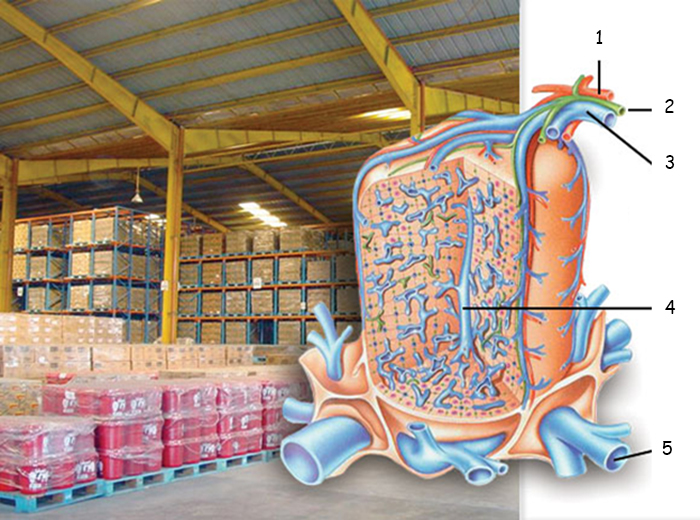 | ||
1. Branch of hepatic artery | 4. Central vein | |
Only a small part of the iron taken into the body is absorbed. The remainder, which is of the greatest importance to the body, however, is never wasted. The excess iron ions are stored by certain cells, as if the body knew that they would be used later. One of the organs that perform such storage functions is the liver. The liver cells work literally like a warehouse, storing excess iron for use at a later date. | ||
The remainder is not wasted, however. Even if the body no longer requires the excess iron ions floating in the bloodstream, they are stored for later use. All the cells in the body, especially the liver cells, store this excess iron within themselves, just as if they knew it was to be needed at a later date. The fact that the cells are seemingly aware of this storage process is of great importance. No cell uses the iron that reaches it at random, aimless and unbounded. No cell throws iron ions away, making a decision different from that of all other cells. They all act as if they were aware that they held a most valuable commodity. This shows us that there is a flawless planning inside the cells, a plan kept under constant control. Clearly this planning and control belong to God, Who maintains and rules all, and is the Creator of the flawlessness in this wondrous system.
It is of course impossible for us to view the presence of God. However, anyone possessed of reason and good conscience can see and comprehend God's absolute and mighty existence by looking around him at examples like this. The proofs of God's existence are obviously everywhere. Our Lord describes His superior artistry in one verse as follows:
He is God—the Creator, the Maker, the Giver of Form. To Him belong the Most Beautiful Names. Everything in the heavens and Earth glorifies Him. He is the Almighty, the All-Wise. (Surat al-Hashr: 64)
24. Mutahhar Yenson, İnsan Biyokimyasi, ("Human Biochemistry"), Beta Basim Yayin Dağitim, p. 484; "The Chemistry of Hemoglobin and Myoglobin,"http://chemed.chem.purdue.edu/genchem/topicreview/bp/1biochem/blood3.html 
25. Textbook of Medical Physiology, p. 496.
26. Bilim ve Teknik, February 1998, Vol. 363, p. 61.
27. Arthur C. Guyton, op. cit., Vol 1, 7th Ed., Nobel Tip Kitabevi, p. 716. 